
A chemical element is a species of atom having the same number of protons in their atomic nuclei. For example, the atomic number of oxygen is 8, so the element oxygen describes all atoms which have 8 protons.

In mathematics, the Fibonacci numbers, commonly denoted Fn form a sequence, called the Fibonacci sequence, such that each number is the sum of the two preceding ones, starting from 0 and 1. That is,

The International Standard Book Number (ISBN) is a numeric commercial book identifier which is intended to be unique. Publishers purchase ISBNs from an affiliate of the International ISBN Agency.
ISO 8601Data elements and interchange formats – Information interchange – Representation of dates and times is an international standard covering the exchange of date- and time-related data. It was issued by the International Organization for Standardization (ISO) and was first published in 1988. The purpose of this standard is to provide an unambiguous and well-defined method of representing dates and times, so as to avoid misinterpretation of numeric representations of dates and times, particularly when data is transferred between countries with different conventions for writing numeric dates and times.

A number is a mathematical object used to count, measure, and label. The original examples are the natural numbers 1, 2, 3, 4, and so forth. A written symbol like "5" that represents a number is called a numeral. A numeral system is an organized way to write and manipulate this type of symbol, for example the Hindu–Arabic numeral system allows combinations of numerical digits like "5" and "0" to represent larger numbers like 50. A numeral in linguistics can refer to a symbol like 5, the words or phrase that names a number, like "five hundred", or other words that mean a specific number, like "dozen". In addition to their use in counting and measuring, numerals are often used for labels, for ordering, and for codes. In common usage, number may refer to a symbol, a word or phrase, or the mathematical object.
1 is a number, and a numerical digit used to represent that number in numerals. It represents a single entity, the unit of counting or measurement. For example, a line segment of unit length is a line segment of length 1. It is also the first of the infinite sequence of natural numbers, followed by 2.
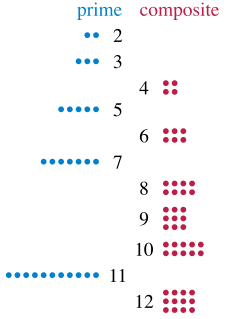
A prime number is a natural number greater than 1 that cannot be formed by multiplying two smaller natural numbers. A natural number greater than 1 that is not prime is called a composite number. For example, 5 is prime because the only ways of writing it as a product, 1 × 5 or 5 × 1, involve 5 itself. However, 6 is composite because it is the product of two numbers that are both smaller than 6. Primes are central in number theory because of the fundamental theorem of arithmetic: every natural number greater than 1 is either a prime itself or can be factorized as a product of primes that is unique up to their order.
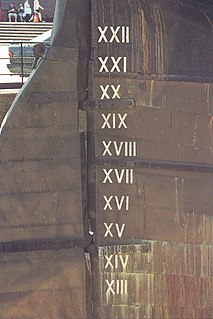
Roman numerals are a numeral system that originated in ancient Rome and remained the usual way of writing numbers throughout Europe well into the Late Middle Ages. Numbers in this system are represented by combinations of letters from the Latin alphabet. Modern usage employs seven symbols, each with a fixed integer value:
0 (zero) is a number, and the numerical digit used to represent that number in numerals. It fulfills a central role in mathematics as the additive identity of the integers, real numbers, and many other algebraic structures. As a digit, 0 is used as a placeholder in place value systems. Names for the number 0 in English include zero, nought (UK), naught (US), nil, or—in contexts where at least one adjacent digit distinguishes it from the letter "O"—oh or o. Informal or slang terms for zero include zilch and zip. Ought and aught, as well as cipher, have also been used historically.

Robert PeterWilliams is an English singer-songwriter and entertainer. He found fame as a member of the pop group Take That from 1989 to 1995, but achieved greater commercial success with his solo career, beginning in 1997. Williams has released seven UK number one singles and eleven out of his twelve studio albums have reached number one in the UK. He is the best-selling British solo artist in the United Kingdom and the best selling non-Latino artist in Latin America. Six of his albums are among the top 100 biggest-selling albums in the United Kingdom–four albums in the top 60–and in 2006 he entered the Guinness Book of World Records for selling 1.6 million tickets of his Close Encounters Tour in a single day.
2 (two) is a number, numeral, and glyph. It is the natural number following 1 and preceding 3. It is the smallest and only even prime number. Because it forms the basis of a duality, it has religious and spiritual significance in many cultures.

The North American Numbering Plan (NANP) is a telephone numbering plan that encompasses twenty-five distinct regions in twenty countries primarily in North America, including the Caribbean. Some North American countries, most notably Mexico, do not participate in the NANP.
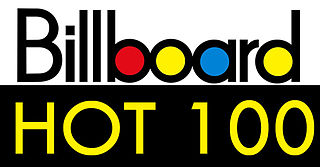
The Billboard Hot 100 is the music industry standard record chart in the United States for songs, published weekly by Billboard magazine. Chart rankings are based on sales, radio play, and online streaming in the United States.
A telephone numbering plan is a type of numbering scheme used in telecommunication to assign telephone numbers to subscriber telephones or other telephony endpoints. Telephone numbers are the addresses of participants in a telephone network, reachable by a system of destination code routing. Telephone numbering plans are defined in each of administrative regions of the public switched telephone network (PSTN) and they are also present in private telephone networks. For public number systems, geographic location plays a role in the sequence of numbers assigned to each telephone subscriber.
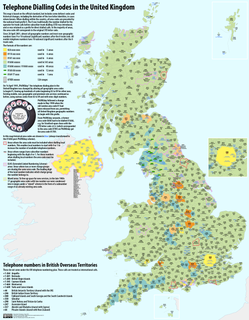
Telephone numbers in the United Kingdom are administered by the UK government's Office of Communications (Ofcom). For this purpose Ofcom established a telephone numbering plan, known as the National Telephone Numbering Plan, which is the system for assigning telephone numbers to subscriber stations.
The Billboard 200 is a record chart ranking the 200 most popular music albums and EPs in the United States. It is published weekly by Billboard magazine. It is frequently used to convey the popularity of an artist or groups of artists. Often, a recording act will be remembered by its "number ones", those of their albums that outperformed all others during at least one week. The chart grew from a weekly top 10 list in 1956 to become a top 200 in May 1967, and acquired its present title in March 1992. Its previous names include the Billboard Top LPs (1961–72), Billboard Top LPs & Tapes (1972–84), Billboard Top 200 Albums (1984–85) and Billboard Top Pop Albums.
The Library of Congress Control Number (LCCN) is a serially-based system of numbering cataloging records in the Library of Congress in the United States. It has nothing to do with the contents of any book, and should not be confused with Library of Congress Classification.
The bibcode is a compact identifier used by several astronomical data systems to uniquely specify literature references.
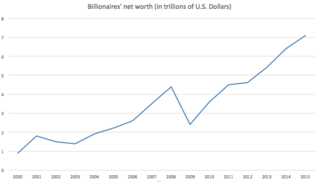
The World's Billionaires is an annual ranking by documented net worth of the wealthiest billionaires in the world, compiled and published in March annually by the American business magazine Forbes. The list was first published in March 1987. The total net worth of each individual on the list is estimated and is cited in United States dollars, based on their documented assets and accounting for debt. Royalty and dictators whose wealth comes from their positions are excluded from these lists. This ranking is an index of the wealthiest documented individuals, excluding and ranking against those with wealth that is not able to be completely ascertained.










